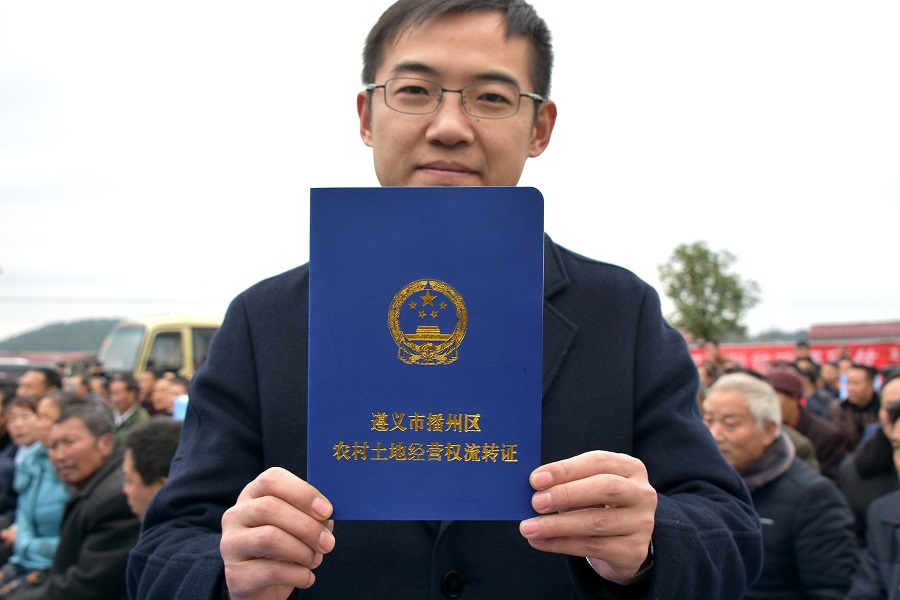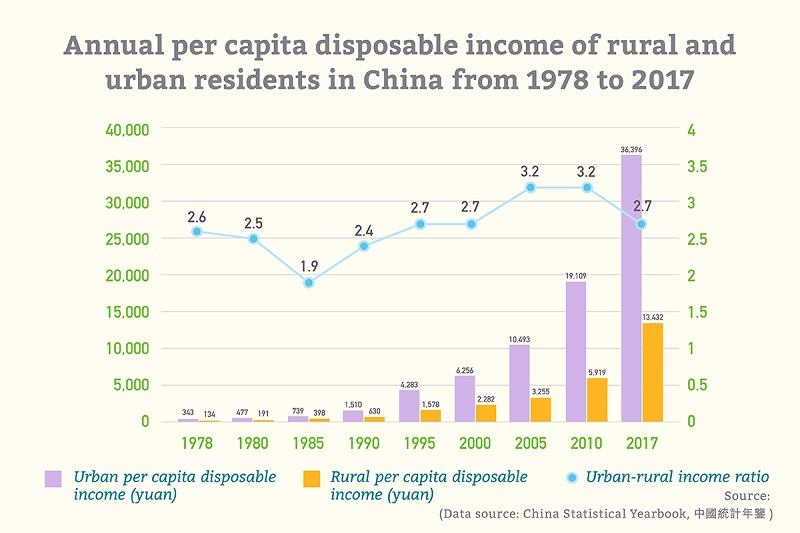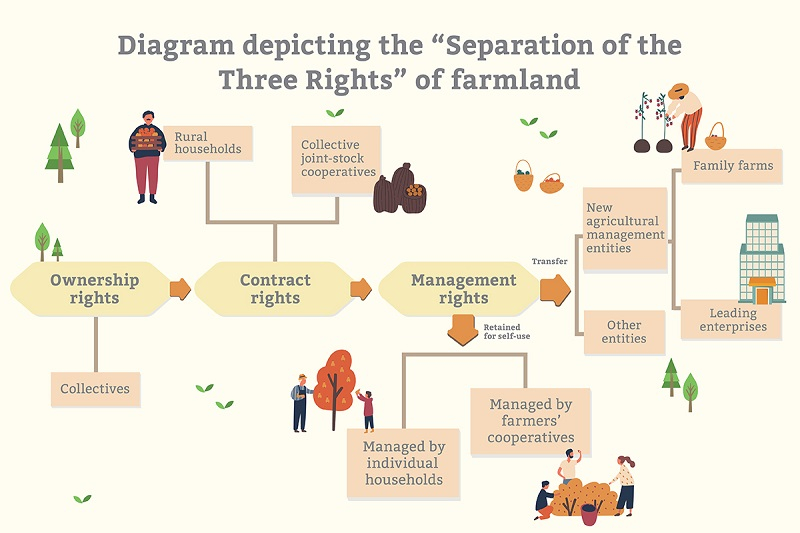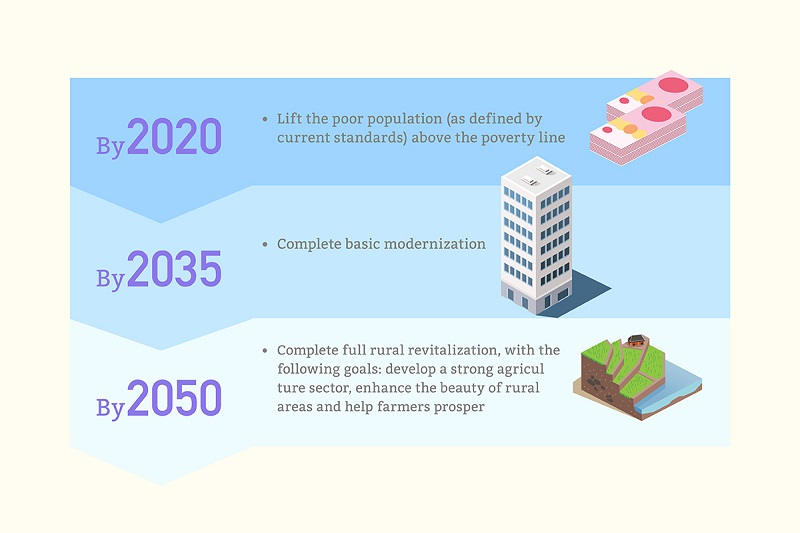For the Chinese government, the mission to lift hundreds of millions of farmers in China -- a major agrarian nation -- out of poverty is an imperative albeit a daunting one. Although implementation of the household responsibility system (家庭聯產承包責任制) (allowing farmers to choose how to manage and what to grow on their land) has enabled farmers to meet their basic needs, the divide between urban and rural areas widened further. The key to developing a strong agricultural sector, enhancing the beauty of China’s rural areas and helping its farmers prosper must begin with the “Separation of Three Rights” -- the separation of rural land ownership rights, contract rights and land management rights -- followed by the twin programs of agricultural modernization and rural revitalization.
For many people, terms like countryside, villages and rural area connote poverty and backwardness, and for good reason: historically and currently most of China’s poverty-stricken regions have been rural areas. To modernize and to fulfill the national goal of building a moderately prosperous society in all respects, China must ensure its villages are not left behind.
Throughout history China has been a largely agrarian nation. According to data from the National Bureau of Statistics (國家統計局) as of the end of 2017, roughly 577 million people -- or 41.48 percent of China’s population - reside in villages. However, if the population of rural migrant workers - those employed in non-agricultural work in cities whose “hukou” (household registration) are in rural areas - are included, the total number of rural “hukou” holders is around 800 million people, about 57.65 percent of China’s population.
Enabling rural dwellers to pursue a prosperous, modern lifestyle is a formidable challenge for the Chinese government. The Rural Revitalization Strategic Plan (鄉村振興戰略規劃) is its response to this challenge.
To thrive and not just survive
To develop a strong agricultural sector, enhance the beauty of rural areas and help farmers prosper -- these policies were stated at the founding of the People’s Republic of China (PRC) in 1949. Since reform and opening-up, a series of rural reforms, spearheaded by the household responsibility system, have had great historic success in mobilizing farmers to maximize production and thus ensure that their basic sustenance needs are met. Nevertheless, the significant progress made in rural areas has been dwarfed by the even greater progress achieved by cities during the same period. This has led to a growing rural-urban gap and emergence of a dualistic rural-urban structure, with cities making rapid socioeconomic progress and rural regions developing at a much more modest pace. This has resulted in significant disparity in basic public services and income levels between the urban and rural populations.
To better adapt to new conditions and compensate the shortfalls in rural development, a strategy to revitalize rural areas was introduced by President Xi Jinping (習近平) in his report delivered at the 19th National Congress of the Communist Party of China (CPC) in October 2017. Following this report, the State Council announced a package of policies via the “No 1 Central Document (中央一號文件)” entitled Opinions of the Central Committee of the CPC and the State Council on Implementing the Strategy for Vitalizing Villages (中共中央國務院關於實施鄉村振興戰略的意見). In the wake of this, Premier Li Keqiang (李克強) placed emphasis on the importance of taking effective steps towards strategic rural revitalization in his Report on the Work of the Government (政府工作報告). In September of the same year, China issued the Strategic Plan for Rural Revitalization (2018 – 2022) (國家鄉村振興戰略規劃2018—2022年) and proceeded to put it into practice.
The rural revitalization strategy underlines the importance of addressing the “three rural issues (agriculture, farmers’ and rural affairs)" in the nation’s path towards modernization, identifying them as the foundation of national well-being and people's livelihood. The strategy also establishes as its overall goal the modernization of agriculture and rural areas.
The strategy for rural revitalization makes it clear that work on the “three rural issues” must adhere to three basic principles:
First is to shore up and continue improving the two-tier land tenure system, which integrates unified with separate management on the basis of household contract management. The collective ownership system for rural land serves as the basis for farmers to share in agricultural prosperity. In the Property Law (物權法) it is stipulated clearly that movable and immovable property belong to village collectives by law and are collectively owned by their members; and that legally, farmers, as tenants of the land, are protected by contract. Under such conditions as permitted by the Separation of Three Rights (三權分置) (rural land ownership rights, contract rights and management rights) those who are not members of collectives can also rent rural land and transfer their land management rights. However, the land contractual rights will remain with the original contractors. Thus, it is up to the original contractors -- the farmers themselves -- to decide whether they would like to manage the land themselves or sub-let the management rights to other entities.

In 2014, after discussion, members of Tangyue Village (塘約村) in Pingba District (平壩區) Anshun City (安順市) Guizhou Province came to the decision that the village would take steps to eradicate poverty and pursue prosperity by adopting large-scale, intensive and professional management. The village launched an initiative of unified confirmation and registration of all seven types of rights -- rural land contractual and management rights (農村土地承包經營權) forest rights, collective land ownership rights, the right to the use of collectively-owned land for construction purposes (集體建設用地使用權) house ownership rights, small scale water conservancy project property rights and rural land collective property rights, before placing them under centralized management by the village. It received strong support from the villagers, who became shareholders via the initiative. Within a few years, they successfully consolidated their land and were able to expand their businesses. This also encouraged those youngsters who had left the village for work elsewhere to return. Thanks to dividends from the changed uses of rural land and employment generated within cooperatives, Tangyue Village transformed from a state-designated “grade two poverty village” (ranked according to national standards) to a moderately prosperous village with a per capita net income of over 10,000 yuan.
The second basic principle of rural revitalization is to safeguard national food security -- ensuring that China has firm control over its own home-grown food supply. China’s food production has been growing continuously since 2004 but the increments were hard-earned while losses were all too easily incurred. Thus there has been a need to prevent major fluctuations in food production that potentially endanger national food security or worse, national economic security.
The future of villages
The rural revitalization plan is designed to fulfill the following goals in three phases over time:
The next questions are: what does “rural revitalization” actually stand for? What would a village look like after revitalization? The answer can be summarized in five points: thriving industries, pleasant living environments, a civilized rural culture, effective governance and affluence for all.
Agriculture will not be the only industry to receive a boost via rural revitalization -- integrated development of the primary, secondary, and tertiary industries in rural areas will be promoted. This will bring forth new industries and new forms of business, creating additional non-rural land-based job opportunities for farmers. In recent years, many villages have ventured into online sales, e-commerce, rural tourism and retirement and wellness services. These initiatives have generated new sources of revenue and employment opportunities.
One example is the scenic Guliaotun Village (姑遼屯) part of Chongzuo City (崇左市) Guangxi, where building “beautiful village” became a new way for less developed region to revitalize. It refurbished 16 rustic residential buildings that housed a total of 48 rooms, and established a center for folk culture and creativity, a courtyard for musical performances, a pottery workshop and a garden restaurant. These come with various supporting amenities and tourist attractions such as a reception center for visitors, a square dedicated to farming traditions, Hezhu Island (荷竹島) and a waterside trail.
Yu Tiantao (于天濤) vice secretary of the township party committee, said this helped the community of 319 households with a population of around 1,450 in at least four ways. First, an annual rental income of 1,500 yuan is generated by each mu (畝) of land leased. Second, rent from residences brought in an annual income of 4,500 yuan per building. Third they received three percent of the tourist area's net profit in annual dividends via share acquisition and financing. Fourth, a variety of new employment options generated by the development of rural tourism provide a monthly income of 2000 to 4000 yuan per villager employee.
Healthy environment has proved to be the village’s greatest economic advantage and most precious asset. To protect it, villages adopted ecological and environmental protection measures such as converting livestock waste into fertilizer so orchards, vegetables and tea plantations could be fertilized with organic waste instead of chemical fertilizer. They also re-cycled both unwanted straw stalks from Northeast China for various purposes and agriculture film. They showed a steadfast commitment to promoting the concept of ecological development which eventually became ingrained in people’s hearts and minds. Thus, not only are the farmers themselves now able to enjoy the pristine environment boasting verdant mountains and limpid waters, they are also safeguarding nature’s self-replenishing bounty for their descendants. As the quality of the rural living environment continues to improve and ‘green’ agricultural practices gain traction, a positive feedback cycle is generated, helping rural industries and farmers increasingly to thrive.
In the future, not only will villages continue to develop and transmit to future generations the finest aspects of traditional rural culture, they will also tread new ground by adopting a more democratic management style that strives to involve all farmers in village governance. Improvements to the rural transportation system and logistics will strengthen the rural infrastructure, in turn generating more wealth and affluence in villages. In conclusion, the goal of rural revitalization is to make agriculture a promising industry, farming the new occupation of choice, and villages a place people are proud to call home.
Towards greener pastures
To realize this vision, the rural revitalization strategy has identified seven paths that must be taken:
The major challenge now facing the agricultural sector is not insufficient production, but rather, low-quality, inefficient production. To address this, it is necessary to strengthen supply-side structural reform in agriculture and facilitate the sector’s transition from one that pursues quantity-based, high-speed and high-yield growth to one that pursues high-quality and sustainable development. In turn this will invigorate the agricultural sector and ultimately help farmers prosper and lead better lives. Achieving organic linkage between small farmers and modern agriculture is the key to the issue.
How should China deal with its unique challenges -- namely that of being a large nation with many small farms -- when it comes to shepherding its farmers through a transition from a peasant economy to modern agriculture?
Reputable produce brands in the Chinese mainland such as Wuchang rice (五常大米) Anji white tea (安吉白茶) and Shouguang vegetables (壽光蔬菜) offer valuable lessons in this regard. Zhu Zaijun (朱在軍) director of Shouguang City Home of Vegetables Cooperative Society (壽光市蔬菜之家聯合社) said promoting the adoption of modern agricultural practices among small farms was made possible by bringing together individual farmers who were struggling on their own to form a cooperative. The cooperative then supports farmers by running standardized tests for soil quality, allocating resources for production, sharing production technologies, providing advice on managing production, fostering traceable quality control, marketing members’ produce under a single brand, developing sales channels and forging a new supply chain to form a closed system. Active brand management has allowed Shouguang vegetables to become synonymous with “high-quality produce that customers’ trust” thus allowing farmers to sell their produce for a much higher profit.
According to Zhang Hongyu (張紅宇) director of the Department of Rural Economy and Management (農村經濟體制與經營管理司) of the Ministry of Agriculture (農業部) new agro-businesses are thriving, with a total of over three million as of late 2017. Among them, 485,000 were family farms, 1.99million were various types of cooperatives, and 390,000 were industrial agricultural businesses. It is also worth noting that the average farmer who was a member of a cooperative during that period typically earned 15 percent to 20 percent more than their non-member counterparts.
Based on the experiences of developed nations, the agricultural sector is not simply destined to decline and fade into insignificance in the course of modernization and urbanization. Even if its GDP share and the farming population decline during the process, with proper planning and adoption of new management strategies, the countryside will play a vital role in meeting the future needs of the people and following the same upwards trajectory enjoyed by China’s more industrial and urban areas.
Agricultural machinery works the land performing backbreaking tasks in place of humans; streams are clearer, hills more verdant; villagers are proud owners of modern, well-built and equipped houses ... In time, a future featuring a strong agriculture sector, scenic rural regions and prosperous farmers will be fully realized as China’s agricultural sector heads into greener pastures.
References:
Guide to Advancing Rural Revitalization -- An Analysis of Highlights of the Rural Revitalization Strategy (推進鄉村振興的行動指南——解讀鄉村振興戰略亮點) Xinhuanet.com, 27 Sept. 2018
How Serious is the Income Disparity in China? Gini Coefficient Now Past Threshold that Warrants Alarm (中國人收入差距有多大? 居民收入基尼係數已超警戒線), Investor Journal (投資者報 ) Aug. 6, 2018
Tangyue Village of Anshun, Guizhou: Where Villagers Become Shareholders and Cash in on the Scenery (貴州安順塘約村:村民為股民,青山變金山), people.com.cn, July 5, 2017
An Accurate Assessment of China’s Rural Revitalization Strategy (準確把握中國鄉村振興戰略) Huang Zuhui (黃祖輝) Chinese Rural Economy (中國農村經濟) April 24, 2018
Verifying the Seven Types of Rural Land Rights Simultaneously has Breathed New Life into Provincial Poverty Village (「七權同確」讓這個省級貧困村脱胎換骨), Farmers’ Daily (農民日報) May 2, 2017
Building of a Chinese Dream - Rural Revitalization (築夢中國鄉村振興) banyuetan.org
Let’s Talk about the Rural Revitalization Strategy (鄉村振興戰略大家談) Common Concepts Program (通俗理論節目) xinhuanet.com









